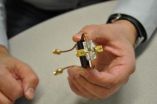(Press-News.org) NEW YORK, February 19, 2014 — Investigators from Memorial Sloan Kettering Cancer Center have reported more encouraging news about one of the most exciting methods of cancer treatment today. The largest clinical study ever conducted to date of patients with advanced leukemia found that 88 percent achieved complete remissions after being treated with genetically modified versions of their own immune cells. The results were published today in Science Translational Medicine.
"These extraordinary results demonstrate that cell therapy is a powerful treatment for patients who have exhausted all conventional therapies," said Michel Sadelain, MD, PhD, Director of the Center for Cell Engineering at Memorial Sloan Kettering and one of the study's senior authors. "Our initial findings have held up in a larger cohort of patients, and we are already looking at new clinical studies to advance this novel therapeutic approach in fighting cancer."
Adult B cell acute lymphoblastic leukemia (B-ALL), a type of blood cancer that develops in B cells, is difficult to treat because the majority of patients relapse. Patients with relapsed B-ALL have few treatment options; only 30 percent respond to salvage chemotherapy. Without a successful bone marrow transplant, few have any hope of long-term survival.
In the current study, 16 patients with relapsed B-ALL were given an infusion of their own genetically modified immune cells, called T cells. The cells were "reeducated" to recognize and destroy cancer cells that contain the protein CD19. While the overall complete response rate for all patients was 88 percent, even those with detectable disease prior to treatment had a complete response rate of 78 percent, far exceeding the complete response rate of salvage chemotherapy alone.
Dennis J. Billy, C.Ss.R, of Wynnewood, Pennsylvania, was one of the first patients to receive this treatment more than two years ago. He was able to successfully undergo a bone marrow transplant and has been cancer-free and back at work teaching theology since 2011. Paolo Cavalli, a restaurant owner from Oxford, Connecticut, remains in complete remission eight months after receiving his personalized T cell treatment.
A History of Scientific Achievements for Cell-Based Therapies
Cell-based, targeted immunotherapy is a new approach to treating cancer that harnesses the body's own immune system to attack and kill cancerous cells. Unlike with a common virus such as the flu, our immune system does not recognize cancer cells as foreign and is therefore at a disadvantage in eradicating the disease. For more than a decade, researchers at Memorial Sloan Kettering have been exploring ways to reengineer the body's own T cells to recognize and attack cancer. In 2003, they were the first to report that T cells engineered to recognize the protein CD19, which is found on B cells, could be used to treat B cell cancers in mice.
"Memorial Sloan Kettering was the first center to report successful outcomes using this CD19-targeted approach in B-ALL patients," said Renier Brentjens, MD, PhD, Director of Cellular Therapeutics at Memorial Sloan Kettering and one of the study's senior authors. "It's extremely gratifying to witness the astonishing results firsthand in my patients, having worked for more than a decade developing this technology from the ground up."
In March 2013, the same team of researchers first reported the results of five patients with advanced B-ALL who were treated with cell therapy. Remarkably, all five patients achieved complete remissions.
Results Demonstrate Potential of New Therapy
In the current study, seven of the 16 patients (44 percent) were able to successfully undergo bone marrow transplantation — the standard of care and the only curative option for B-ALL patients — following treatment. Three patients were ineligible due to failure to achieve a complete remission, three were ineligible due to preexisting medical conditions, two declined, and one is still being evaluated for a potential bone marrow transplant. Historically, only 5 percent of patients with relapsed B-ALL have been able to transition to bone marrow transplantation.
The study also provides guidelines for managing side effects of cell therapy, which can include severe flu-like symptoms such as fever, muscle pain, low blood pressure, and difficulty breathing, referred to as cytokine release syndrome. The researchers developed diagnostic criteria and a laboratory test that can identify which patients are at greater risk for developing this syndrome.
Additional studies to determine whether cell therapy can be applied to other types of cancer are already underway, and studies to test whether B-ALL patients would benefit from receiving targeted immunotherapy as frontline treatment are being planned.
INFORMATION:
This research was supported by the National Cancer Institute, the Terry Fox Foundation, the American Society of Hematology-Amos Medical Faculty Development Program, the Alliance for Cancer Gene Therapy, the Mallah Foundation, the Majors Foundation, the Damon Runyon Cancer Research Foundation, Kate's Team, Mr. William H. Goodwin and Mrs. Alice Goodwin and the Commonwealth Cancer Foundation for Research, the Carson Family Fund, and the Experimental Therapeutics Center of Memorial Sloan Kettering.
Editor's note: Dr. Sadelain and Dr. Brentjens are co-holders of a patent that covers the technology used to create the modified T cells in this study. The technology was licensed to Juno Therapeutics in December 2013.
About Memorial Sloan Kettering Cancer Center
We are the world's oldest and largest private cancer center, home to more than 12,000 physicians, scientists, nurses, and staff united by a relentless dedication to conquering cancer. As an independent institution, we combine 130 years of research and clinical leadership with the freedom to provide highly individualized, exceptional care to each patient. And our always-evolving educational programs continue to train new leaders in the field, here and around the world. For more information, go to http://www.mskcc.org.
Cell therapy shows remarkable ability to eradicate cancer in clinical study
Genetically modified T cells induced complete remissions in 88 percent of advanced leukemia patients treated
2014-02-19
ELSE PRESS RELEASES FROM THIS DATE:
LGBT youth face greater cancer risks, CCNY-led study
2014-02-19
A new study led by City College of New York psychologist Margaret Rosario found that youths of same-sex orientation are more likely to engage in behaviors associated with cancer risk than heterosexuals. The peer-reviewed findings appear in the February 2014 issue of the American Journal of Public Health.
Titled "Sexual Orientation Disparities in Cancer-Related Risk Behaviors of Tobacco, Alcohol, Sexual Behaviors, and Diet and Physical Activity: Pooled Youth Risk Behavior Surveys," the study pooled YRBS (Youth Risk Behavior Survey) data from 2005 and 2007. The YRBS is ...
Using holograms to improve electronic devices
2014-02-19
RIVERSIDE, Calif. (http://www.ucr.edu) — A team of researchers from the University of California, Riverside Bourns College of Engineering and Russian Academy of Science have demonstrated a new type of holographic memory device that could provide unprecedented data storage capacity and data processing capabilities in electronic devices.
The new type of memory device uses spin waves – a collective oscillation of spins in magnetic materials – instead of the optical beams. Spin waves are advantageous because spin wave devices are compatible with the conventional electronic ...
Statistics research could build consensus around climate predictions
2014-02-19
Philadelphia, PA—Vast amounts of data related to climate change are being compiled by research groups all over the world. Data from these many and various sources results in different climate projections; hence, the need arises to combine information across data sets to arrive at a consensus regarding future climate estimates.
In a paper published last December in the SIAM Journal on Uncertainty Quantification, authors Matthew Heaton, Tamara Greasby, and Stephan Sain propose a statistical hierarchical Bayesian model that consolidates climate change information ...
Smellizing -- imagining a product's smell -- increases consumer desire, study finds
2014-02-19
Seeing is believing, but smellizing – a new term for prompting consumers to imagine the smell of a product – could be the next step toward more effective advertising.
Researchers came to this conclusion through four studies of products most of us would like to smellize: cookies and cake.
Professor of Marketing Maureen Morrin of Temple University's Fox School of Business co-authored Smellizing Cookies and Salivating: A Focus on Olfactory Imagery to examine the impact imagining what a food smells like would have on consumer behavior.
"Before we started this project, ...
Discovery by Baylor University researchers sheds new light on the habitat of early apes
2014-02-19
WACO, Texas (Feb. 18, 2014)-- Baylor University researchers, in collaboration with an international team of scientists, have discovered definitive evidence of the environment inhabited by the early ape Proconsul on Rusinga Island, Kenya. The groundbreaking discovery provides additional information that will help scientists understand and interpret the connection between habitat preferences and the early diversification of the ape-human lineage.
Their research findings--published this month in Nature Communications--demonstrate that Proconsul and its primate relative Dendropithecus ...
Graduate student makes major discovery about seal evolution
2014-02-19
Ottawa, February, 19, 2014—In the world of science, one of the most exciting things a researcher can do is pin down an answer to a widely asked question. This experience came early for Carleton University graduate Thomas Cullen, who made a discovery about pinnipeds—the suborder that makes up seals, sea lions and walruses—while doing research for his Master's degree under the supervision of Canadian Museum of Nature palaeontologist Dr. Natalia Rybczynski.
His discovery, published the journal Evolution, relates to sexual dimorphism (a large variance in size between males ...
Huntington's disease: Hot on the trail of misfolded proteins' toxic modus operandi
2014-02-19
WASHINGTON D.C. Feb. 19, 2014 -- Proteins are the workhorses of the cell, and their correctly folded three-dimensional structures are critical to cellular functions. Misfolded structures often fail to properly perform these vital jobs, leading to cellular stress and devastating neurodegenerative disorders such as Alzheimer's, Parkinson's and Huntington's disease.
In comparison with the mysteries of Alzheimer's or Parkinson's disease, Huntington's disease has a seemingly simple culprit: an expansion in the polyglutamine (polyQ) tract of a protein called "Huntingtin" (Htt). ...
Rutgers scientists identify structure of virus that could lead to hepatitis C vaccine
2014-02-19
Rutgers University scientists have determined the structure of a hepatitis C surface protein, a finding that could assist in the development of a vaccine to halt the spread of the the deadly disease that has infected 3.2 million Americans.
Joseph Marcotrigiano, associate professor of chemistry and chemical biology, says this new research – published online today in Nature – describes an outer region of hepatitis C that enables the virus to evade the body's natural immune system response, causing persistent, chronic infection.
Hepatitis C is constantly mutating, allowing ...
The ups and downs of early atmospheric oxygen
2014-02-19
RIVERSIDE, Calif. — A team of biogeochemists at the University of California, Riverside, give us a nontraditional way of thinking about the earliest accumulation of oxygen in the atmosphere, arguably the most important biological event in Earth history.
A general consensus asserts that appreciable oxygen first accumulated in Earth's atmosphere around 2.3 billion years ago during the so-called Great Oxidation Event (GOE). However, a new picture is emerging: Oxygen production by photosynthetic cyanobacteria may have initiated as early as 3 billion years ago, with oxygen ...
NuSTAR telescope takes first peek into core of supernova
2014-02-19
Astronomers for the first time have peered into the heart of an exploding star in the final minutes of its existence.
The feat is one of the primary goals of NASA's NuSTAR mission, launched in June 2012 to measure high-energy X-ray emissions from exploding stars, or supernovae, and black holes, including the massive black hole at the center of our Milky Way Galaxy.
The NuSTAR team reported in this week's issue of the journal Nature the first map of titanium thrown out from the core of a star that exploded in 1671. That explosion produced the beautiful supernova remnant ...
LAST 30 PRESS RELEASES:
Electrodes created using light
Second-hand gift-giving is a well-deliberated decision
How human interaction drove evolution to make bears less aggressive
National Poll: Few parents offer teens guidance on healthy eating during holiday season
Cannabis derivatives could provide new ovarian cancer treatments
Raising strong yeast as a petroleum substitute
Clues to the origin of hot Jupiters hidden in their orbits
Canada’s reduced pledge to Global Fund will impact domestic health
1 in 4 children with major traumatic injuries not cared for in pediatric trauma centres
Duke and Duke-NUS’ joint cross-population research to uncover "East-West" differences in disease and care
Scientists to ‘spy’ on cancer- immune cell interactions using quantum technology breakthrough
Tech savvy users have most digital concerns
Making lighter work of calculating fluid and heat flow
Normalizing blood sugar can halve heart attack risk
Lowering blood sugar cuts heart attack risk in people with prediabetes
Study links genetic variants to risk of blinding eye disease in premature infants
Non-opioid ‘pain sponge’ therapy halts cartilage degeneration and relieves chronic pain
AI can pick up cultural values by mimicking how kids learn
China’s ecological redlines offer fast track to 30 x 30 global conservation goal
Invisible indoor threats: emerging household contaminants and their growing risks to human health
Adding antibody treatment to chemo boosts outcomes for children with rare cancer
Germline pathogenic variants among women without a history of breast cancer
Tanning beds triple melanoma risk, potentially causing broad DNA damage
Unique bond identified as key to viral infection speed
Indoor tanning makes youthful skin much older on a genetic level
Mouse model sheds new light on the causes and potential solutions to human GI problems linked to muscular dystrophy
The Journal of Nuclear Medicine ahead-of-print tip sheet: December 12, 2025
Smarter tools for peering into the microscopic world
Applications open for funding to conduct research in the Kinsey Institute archives
Global measure underestimates the severity of food insecurity
[Press-News.org] Cell therapy shows remarkable ability to eradicate cancer in clinical studyGenetically modified T cells induced complete remissions in 88 percent of advanced leukemia patients treated







